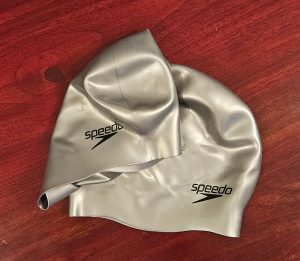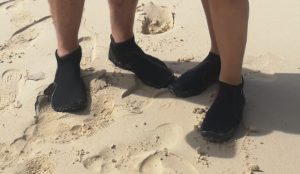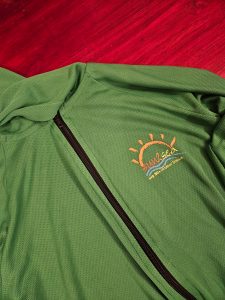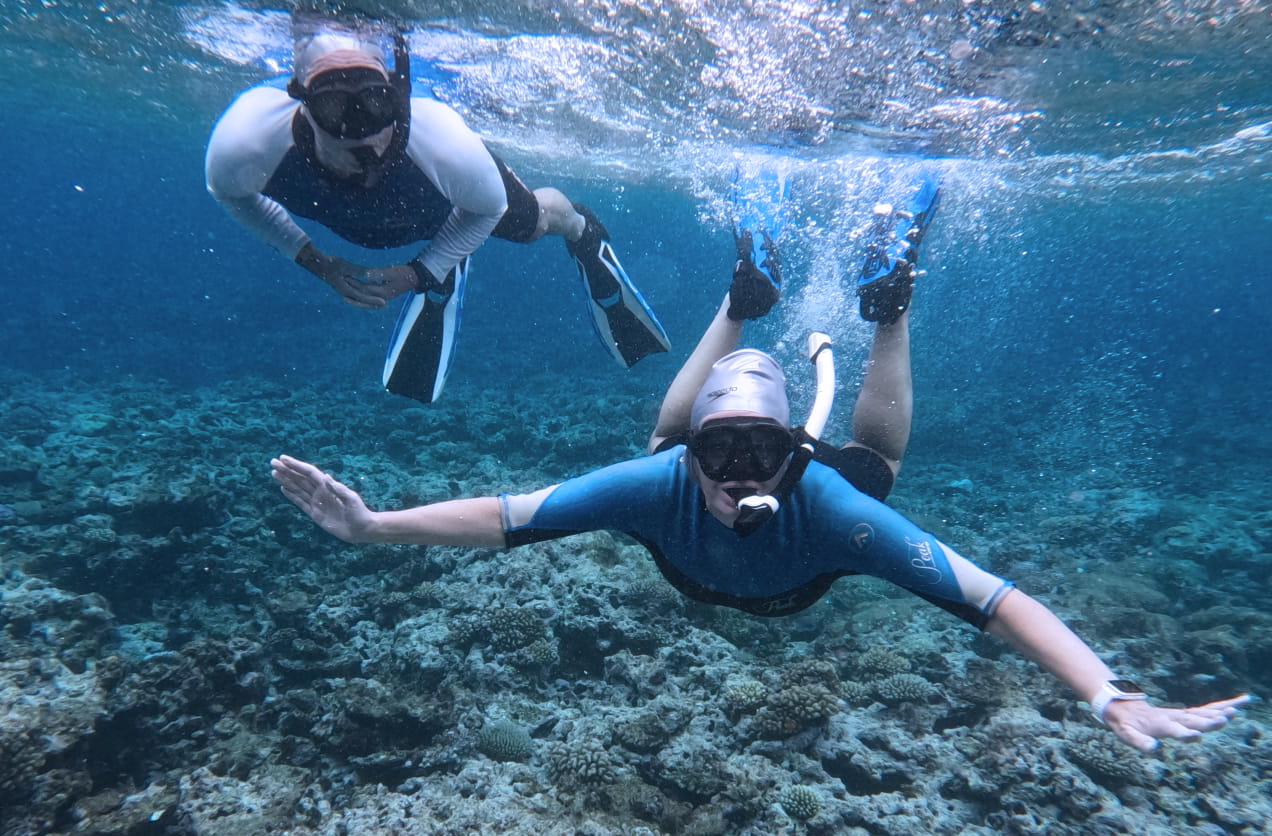Our snorkelling gear
We included this page on our snorkelling gear because we are often asked what gear do you use?
Importantly, we paid for all our stuff. We receive no endorsements, discount, or payment for mentioning any of this. We encourage everyone to go to your local shops and try everything on and ask lots and lots of questions. Try to buy local if you can because this supports the local community.
Ok, so the photo of us underwater isn’t very flattering, and I put it down to the swim cap, but heh who’s looking!
Masks
Arguably the most important piece of equipment! You can’t spend enough time or effort working out the best mask for your face. If you can’t see or you are uncomfortable in the water – it’s all over!
We only use masks constructed with a black coloured skirt. The reason is simple. It blocks light entering through the side of the mask and so provides much much better vision of the amazing underwater environment. Mel wares a Rob Allen Cubera mask. Gerard uses an old Tusa Intega.
Snorkel
We have used loads of different types of snorkels. We prefer a dry top snorkel. The simple reason is when the water is choppy or waves are rocking, the dry top prevents water coming down the pipe.
Most modern snorkels all have purge values which we find a sensible safety feature (make sure to keep the valve clean and free of sand). A local shop called Adreno sell their own dry top which we both use, Adreno Elite Dry Top snorkel, and we’ve had a few small problems with them. But the mouth piece is pretty comfy, has an exhaust valve to purge water and a dry top design.
The quick-release snorkel keeper that attaches to the mask strap has become loose over time (a couple of years) and is frustrating when it comes undone. We’ll be on the lookout for a better replacement soon.
Swim cap

So .. the swim cap. There’s nothing worse than trying to see things when hair gets into your eyes and if you happen to have a lack of hair it’s even more worse if you get your scone burned.
So, we tried a latex swimming pool cap and we haven’t looked back. The real bonus is that your snorkelling guide or tour operator can easily spot you in the water either from the boat or if they’re snorkelling near you – we’ve been told that time and again – so it’s a great safety feature.
We’ve noticed that the latex lasts for about year in salt water so it has to be replaced, it gets too sticky otherwise. We’re on the lookout for an alternative to latex that doesn’t need replacing. The reason we opt for the latex, rather than plastic, is that it’s more gentle on your hair when you’re trying to put it on.
Be warned. You don’t look pretty.
Fins and reef shoes (diving boots)

We snorkel in loads of different places, off the beach, off the pier, over rocks and off boats. So, getting to the water sometimes requires wearing protective foot ware to protect our feet and then fitting an open heel fin once we are in the water.
Mel uses a Tusa hard sole bootie matched with some Cressi Frog Plus open heel fins. Gerard uses a standard reef bootie and Aqua Lung Phazer open heel fins.
Reef safe sunscreen
This is a must. We don’t use ordinary sunscreen – it has to be reef safe. We find it’s easier to buy before we fly because (unbelievably) some shops don’t stock it.
One way we can contribute to looking after the world’s reefs is to use the right sunscreen protection.
Rashie

This is a serious MUST, especially if you’re swimming in Australian waters or in the Pacific. The sun just fries you and you need to protect yourself from skin cancer.
Rashies are slowly improving – you can get them in UPF 50+ now – but they do deteriorate after a few swims in salt water.
A much better alternative is a great Australian product called Sun2Sea. They’ve got great tops that zip up the front, full length on the arms and even have a hoodie. They are so easy to wear in the water and protect you from the sun or the jellyfish in stinger season.
Wetsuit
We’ve both got spring suits and they’ve been handy when we’ve visited another country that’s off season and the water temperature’s low. It’s worth thinking about stashing one in your bag if it’s not the dead of summer. Our wetsuits have made sure that our snorkelling has always been enjoyable temperature wise.
Waterproof bag
If we ever need to take a personal item with us underwater (which is rare – but has included a security door card, credit card and car key fob) we use a DiCAPac phone bag. We never take a phone, but this phone bag is designed to keep a few small contents dry and is perfect for us.
Gear bag
If you are flying – this is a critical consideration! Your gear needs to arrive as safely and intact as you.
We use a Osprey Transporter Wheeled Duffel 60L. This fits all our gear neatly (masks travel in protective cases), has a tough framed construction, readily fits an RSA security lock and is very easy to wheel around. It also stands upright which is very useful in tight spaces.
Sea sickness tablets
I (Mel) get sea sick – yes! it kills me – and I wasn’t going to let that get in the way of snorkelling. I take a trusty pack of sea sickness tablets with me whenever we go away and I’ve got the dosage down pat so that I can enjoy snorkelling in choppy or wavy waters and boat rides.
Here’s a great guide on snorkelling gear by the S.C.U.B.A. doctor.



